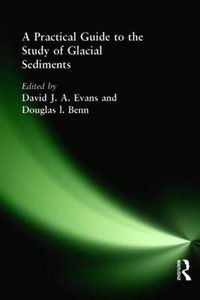
endast ny
A Practical Guide to the Study of Glacial Sediments
Sediments are the most valuable form of physical evidence for past Earth surface processes. They have the potential to build up an archive of events and provide a window into the past. Through careful examination of sediments the shifting patterns of surface processes across space and time are revealed, allowing us to reconstruct past environments and environmental change.
A Practical Guide to the Study of Glacial Sediments is a guide to the standard techniques employed to read the sedimentary record of former glaciers and ice sheets. It demonstrates that the often complex and fragmentary glacial sedimentary record can, when examined systematically and rationally, provide detailed insights into former environments and climates in places where no other evidence is available. The complementary techniques covered in this book include: facies description, grain size analysis, clast form assessment, clast macrofabric analysis, micromorphology, particle lithology and assessment of engineering properties. They yield consistent and meaningful results in a range of glacial depositional environments throughout the world, from the high Arctic to the Himalayas.
A Practical Guide to the Study of Glacial Sediments provides students and researchers with a clear and accessible guide to recording and interpreting glacial successions wherever the location.
Utgiven: 2004
ISBN: 9780340759592
Förlag: Hodder Arnold
Format: Häftad
Språk: Engelska
Sidor: 280 st
Sediments are the most valuable form of physical evidence for past Earth surface processes. They have the potential to build up an archive of events and provide a window into the past. Through careful examination of sediments the shifting patterns of surface processes across space and time are revealed, allowing us to reconstruct past environments and environmental change.
A Practical Guide to the Study of Glacial Sediments is a guide to the standard techniques employed to read the sedimentary record of former glaciers and ice sheets. It demonstrates that the often complex and fragmentary glacial sedimentary record can, when examined systematically and rationally, provide detailed insights into former environments and climates in places where no other evidence is available. The complementary techniques covered in this book include: facies description, grain size analysis, clast form assessment, clast macrofabric analysis, micromorphology, particle lithology and assessment of engineering properties. They yield consistent and meaningful results in a range of glacial depositional environments throughout the world, from the high Arctic to the Himalayas.
A Practical Guide to the Study of Glacial Sediments provides students and researchers with a clear and accessible guide to recording and interpreting glacial successions wherever the location.
Ny bok
457 kr481 kr
5% studentrabatt med Studentapan
Begagnad bok (0 st)
Varje vecka tillkommer tusentals nya säljare. Bevaka boken så får du meddelande när den finns tillgänglig igen.



